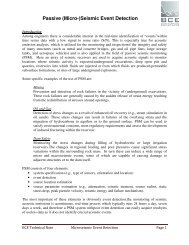SC3-RAV™ 2011 - Baziw Consulting Engineers Ltd.
SC3-RAV™ 2011 - Baziw Consulting Engineers Ltd.
SC3-RAV™ 2011 - Baziw Consulting Engineers Ltd.
Create successful ePaper yourself
Turn your PDF publications into a flip-book with our unique Google optimized e-Paper software.
BCE <strong>SC3</strong>RAV <strong>2011</strong> Seismic Data Analysis Software<br />
• It obtains two independent velocity<br />
estimates for each depth increment<br />
by comparing source wave<br />
generated on both the right and left<br />
side of the seismic probe.<br />
Figure 3 shows the dialog box which<br />
appears when the Crosscorrelation<br />
Technique analysis option is selected.<br />
3.1.1.1 Analyze by Pairs<br />
The Analyze by Pairs option under the<br />
Crosscorrelation Technique refers to<br />
processing two seismic traces at a time at<br />
different depth increments in order to<br />
derive the seismic interval velocities.<br />
Referring to Figure 3, running this option<br />
requires the specification of the input file<br />
at depth 1 and another file at depth 2.<br />
Figure 4 illustrates the dialog box for<br />
inputting these seismic data files. It is<br />
very important that these files correspond<br />
to the depths of penetration where depth2<br />
is greater than depth1. In addition the<br />
sampling rate for the two traces must be<br />
the same and they should both be<br />
equivalently polarized. However, enabling<br />
check box buttons Depth (1-2): Change<br />
Polarity allows for inverting (flipping) data<br />
in a specific file.<br />
Figure 3: Crosscorrelation Technique Interval<br />
Velocities dialog box<br />
Figure 4: File Input dialog box<br />
The Analysis by Pairs can be done either Automatically or Manually, and these options are<br />
explained in Sections 3.1.1.1.1 and 3.1.1.1.2, respectively. The user should select the type of<br />
analysis to be conducted. Once the seismic files are inputted and the type of analysis is<br />
specified, the Begin Processing button is selected.<br />
3.1.1.1.1 Automatic Filtering<br />
The Automatic Filtering option refers to processing the in-situ seismic data without displaying<br />
frequency spectra and filtered traces. This option can be used on a site with which the user is<br />
familiar in order to save time. The Automatic Filtering option will use the sampling rate<br />
specified when the data is acquired, and will automatically reduce the seismic traces, calculate<br />
and display the corresponding velocity, accuracy and relative time shift. The Automatic<br />
Version 11.1.0 Page 5




